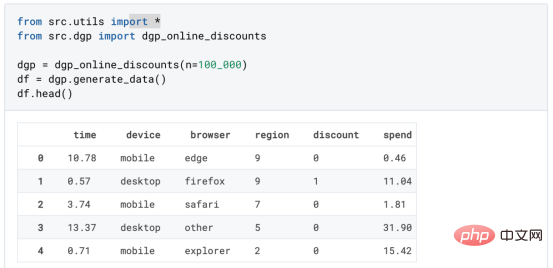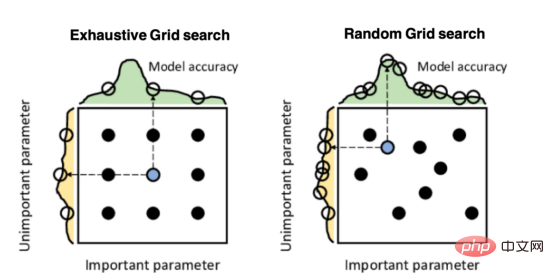
Transformer models are very sensitive to the values of hyperparameters, which means that small hyperparameter changes may significantly affect the performance of the model. Therefore, tuning the hyperparameters of the Transformer model to obtain the best performance on a specific task is a challenging task.
One way to adjust the hyperparameters of the Transformer model is through the process of hyperparameter optimization. Hyperparameter optimization involves systematically searching for combinations of hyperparameter values that achieve the best performance on the validation set. Grid search, random search, and Bayesian optimization are several commonly used hyperparameter optimization methods. However, these methods are often time-consuming and computationally intensive. Therefore, time cost and computational resource constraints need to be weighed when choosing a hyperparameter optimization method.
Grid search
Grid search is a method of hyperparameter optimization. It is necessary to specify a grid of hyperparameter values, and for each set of values Train and evaluate models.
For example, if we want to adjust the learning rate and batch size of the Transformer model, we can choose the best hyperparameter values through grid search. Suppose we set the learning rate to 0.01, 0.1 and 1.0 and the batch size to 16, 32 and 64. By training and evaluating all possible combinations, we will end up with 9 different models (3 learning rates x 3 batch sizes). In this way, we can compare the impact of different hyperparameter combinations on model performance and select optimal hyperparameter values to improve model accuracy and performance.
The model that performs best on the validation set is then selected as the best model, and the final model is trained on the full training set using the corresponding hyperparameter values.
Grid search can be an effective method for hyperparameter optimization, but it is computationally intensive because it involves training and evaluating a large number of models. Furthermore, it can be difficult to specify an appropriate grid of hyperparameter values because the optimal values may depend on the specific task and dataset.
Random Search
Random search is another hyperparameter optimization method that involves sampling random combinations of hyperparameter values and Evaluate the corresponding model on the validation set.
Unlike grid search, which evaluates a fixed set of hyperparameter combinations, random search allows the search to cover a wider range of hyperparameter values because it does not rely on a predefined grid. This is particularly useful when the optimal hyperparameter values are not known in advance and may fall outside the range of values specified in the grid.
To perform a random search, we first define a distribution for each hyperparameter, such as a uniform distribution or a normal distribution. We then draw random combinations of hyperparameter values from these distributions and train and evaluate models for each combination. The process is repeated a fixed number of times and the model that performs best on the validation set is selected as the best model.
Random search is a more efficient hyperparameter optimization method than grid search because it does not require training and evaluating as many models. However, it is not easy to find optimal hyperparameter values compared to more complex methods such as grid search or Bayesian optimization.
Bayesian Optimization
Bayesian optimization is a hyperparameter optimization method based on Bayesian statistical principles. This is an iterative process that involves building a probabilistic model of the objective function based on the hyperparameter values that have been evaluated so far (e.g., validation loss for a machine learning model). The model is then used to select the next set of hyperparameter values to evaluate, with the goal of finding the combination of values that minimizes the objective function.
A key advantage of Bayesian optimization is that it can incorporate prior knowledge about the objective function through the use of probabilistic models, which compared to other methods such as random search or grid search. This can make it more efficient to find the optimal solution. It can also handle constraints on hyperparameter values and can be used to optimize objective functions that are expensive to evaluate, such as those required to train machine learning models.
However, Bayesian optimization is more computationally intensive than other methods because it involves building and updating a probabilistic model at each iteration. It may also be more difficult to implement, as it requires specifying a probabilistic model and selecting hyperparameters for the optimization process itself.
Reinforcement Learning
Reinforcement learning (RL) is a machine learning method that involves an agent learning to take actions in an environment to maximize rewards Signal. It has been used to optimize various aspects of machine learning systems, including hyperparameters.
In the context of hyperparameter optimization, reinforcement learning can be used to learn a policy that maps a set of hyperparameters to actions (e.g., using these hyperparameters to train a machine learning model). The agent can then learn to adjust the hyperparameters based on the model's performance to maximize the reward signal related to the model's performance.
Reinforcement learning has been applied to hyperparameter optimization of various types of machine learning models. In principle, it can also be applied to the optimization of Transformer model hyperparameters.
However, reinforcement learning-based hyperparameter optimization can be difficult to implement and requires large amounts of data and computation to be effective. Moreover, reinforcement learning is sensitive to the choice of reward function and prone to overfitting. Therefore, reinforcement learning-based hyperparameter optimization is not as widely used as other methods.
The above is the detailed content of Hyperparameter method for optimizing Transformer model. For more information, please follow other related articles on the PHP Chinese website!
 解读CRISP-ML(Q):机器学习生命周期流程Apr 08, 2023 pm 01:21 PM
解读CRISP-ML(Q):机器学习生命周期流程Apr 08, 2023 pm 01:21 PM译者 | 布加迪审校 | 孙淑娟目前,没有用于构建和管理机器学习(ML)应用程序的标准实践。机器学习项目组织得不好,缺乏可重复性,而且从长远来看容易彻底失败。因此,我们需要一套流程来帮助自己在整个机器学习生命周期中保持质量、可持续性、稳健性和成本管理。图1. 机器学习开发生命周期流程使用质量保证方法开发机器学习应用程序的跨行业标准流程(CRISP-ML(Q))是CRISP-DM的升级版,以确保机器学习产品的质量。CRISP-ML(Q)有六个单独的阶段:1. 业务和数据理解2. 数据准备3. 模型
 2023年机器学习的十大概念和技术Apr 04, 2023 pm 12:30 PM
2023年机器学习的十大概念和技术Apr 04, 2023 pm 12:30 PM机器学习是一个不断发展的学科,一直在创造新的想法和技术。本文罗列了2023年机器学习的十大概念和技术。 本文罗列了2023年机器学习的十大概念和技术。2023年机器学习的十大概念和技术是一个教计算机从数据中学习的过程,无需明确的编程。机器学习是一个不断发展的学科,一直在创造新的想法和技术。为了保持领先,数据科学家应该关注其中一些网站,以跟上最新的发展。这将有助于了解机器学习中的技术如何在实践中使用,并为自己的业务或工作领域中的可能应用提供想法。2023年机器学习的十大概念和技术:1. 深度神经网
 基于因果森林算法的决策定位应用Apr 08, 2023 am 11:21 AM
基于因果森林算法的决策定位应用Apr 08, 2023 am 11:21 AM译者 | 朱先忠审校 | 孙淑娟在我之前的博客中,我们已经了解了如何使用因果树来评估政策的异质处理效应。如果你还没有阅读过,我建议你在阅读本文前先读一遍,因为我们在本文中认为你已经了解了此文中的部分与本文相关的内容。为什么是异质处理效应(HTE:heterogenous treatment effects)呢?首先,对异质处理效应的估计允许我们根据它们的预期结果(疾病、公司收入、客户满意度等)选择提供处理(药物、广告、产品等)的用户(患者、用户、客户等)。换句话说,估计HTE有助于我
 使用PyTorch进行小样本学习的图像分类Apr 09, 2023 am 10:51 AM
使用PyTorch进行小样本学习的图像分类Apr 09, 2023 am 10:51 AM近年来,基于深度学习的模型在目标检测和图像识别等任务中表现出色。像ImageNet这样具有挑战性的图像分类数据集,包含1000种不同的对象分类,现在一些模型已经超过了人类水平上。但是这些模型依赖于监督训练流程,标记训练数据的可用性对它们有重大影响,并且模型能够检测到的类别也仅限于它们接受训练的类。由于在训练过程中没有足够的标记图像用于所有类,这些模型在现实环境中可能不太有用。并且我们希望的模型能够识别它在训练期间没有见到过的类,因为几乎不可能在所有潜在对象的图像上进行训练。我们将从几个样本中学习
 LazyPredict:为你选择最佳ML模型!Apr 06, 2023 pm 08:45 PM
LazyPredict:为你选择最佳ML模型!Apr 06, 2023 pm 08:45 PM本文讨论使用LazyPredict来创建简单的ML模型。LazyPredict创建机器学习模型的特点是不需要大量的代码,同时在不修改参数的情况下进行多模型拟合,从而在众多模型中选出性能最佳的一个。 摘要本文讨论使用LazyPredict来创建简单的ML模型。LazyPredict创建机器学习模型的特点是不需要大量的代码,同时在不修改参数的情况下进行多模型拟合,从而在众多模型中选出性能最佳的一个。本文包括的内容如下:简介LazyPredict模块的安装在分类模型中实施LazyPredict
 Mango:基于Python环境的贝叶斯优化新方法Apr 08, 2023 pm 12:44 PM
Mango:基于Python环境的贝叶斯优化新方法Apr 08, 2023 pm 12:44 PM译者 | 朱先忠审校 | 孙淑娟引言模型超参数(或模型设置)的优化可能是训练机器学习算法中最重要的一步,因为它可以找到最小化模型损失函数的最佳参数。这一步对于构建不易过拟合的泛化模型也是必不可少的。优化模型超参数的最著名技术是穷举网格搜索和随机网格搜索。在第一种方法中,搜索空间被定义为跨越每个模型超参数的域的网格。通过在网格的每个点上训练模型来获得最优超参数。尽管网格搜索非常容易实现,但它在计算上变得昂贵,尤其是当要优化的变量数量很大时。另一方面,随机网格搜索是一种更快的优化方法,可以提供更好的
 超参数优化比较之网格搜索、随机搜索和贝叶斯优化Apr 04, 2023 pm 12:05 PM
超参数优化比较之网格搜索、随机搜索和贝叶斯优化Apr 04, 2023 pm 12:05 PM本文将详细介绍用来提高机器学习效果的最常见的超参数优化方法。 译者 | 朱先忠审校 | 孙淑娟简介通常,在尝试改进机器学习模型时,人们首先想到的解决方案是添加更多的训练数据。额外的数据通常是有帮助(在某些情况下除外)的,但生成高质量的数据可能非常昂贵。通过使用现有数据获得最佳模型性能,超参数优化可以节省我们的时间和资源。顾名思义,超参数优化是为机器学习模型确定最佳超参数组合以满足优化函数(即,给定研究中的数据集,最大化模型的性能)的过程。换句话说,每个模型都会提供多个有关选项的调整“按钮
 人工智能自动获取知识和技能,实现自我完善的过程是什么Aug 24, 2022 am 11:57 AM
人工智能自动获取知识和技能,实现自我完善的过程是什么Aug 24, 2022 am 11:57 AM实现自我完善的过程是“机器学习”。机器学习是人工智能核心,是使计算机具有智能的根本途径;它使计算机能模拟人的学习行为,自动地通过学习来获取知识和技能,不断改善性能,实现自我完善。机器学习主要研究三方面问题:1、学习机理,人类获取知识、技能和抽象概念的天赋能力;2、学习方法,对生物学习机理进行简化的基础上,用计算的方法进行再现;3、学习系统,能够在一定程度上实现机器学习的系统。


Hot AI Tools

Undresser.AI Undress
AI-powered app for creating realistic nude photos

AI Clothes Remover
Online AI tool for removing clothes from photos.

Undress AI Tool
Undress images for free

Clothoff.io
AI clothes remover

AI Hentai Generator
Generate AI Hentai for free.

Hot Article

Hot Tools

VSCode Windows 64-bit Download
A free and powerful IDE editor launched by Microsoft

PhpStorm Mac version
The latest (2018.2.1) professional PHP integrated development tool

DVWA
Damn Vulnerable Web App (DVWA) is a PHP/MySQL web application that is very vulnerable. Its main goals are to be an aid for security professionals to test their skills and tools in a legal environment, to help web developers better understand the process of securing web applications, and to help teachers/students teach/learn in a classroom environment Web application security. The goal of DVWA is to practice some of the most common web vulnerabilities through a simple and straightforward interface, with varying degrees of difficulty. Please note that this software

Zend Studio 13.0.1
Powerful PHP integrated development environment

EditPlus Chinese cracked version
Small size, syntax highlighting, does not support code prompt function







